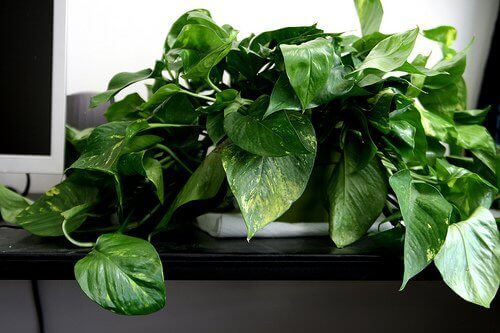Pothos Plant to Purify the Air in Your Home

The pothos plant, or Epipremnum aureum, is a hanging and climbing plant very common in homes today. Two of its greatest health benefits, however, are relatively unknown. Pothos cleans the air in the room and helps relax your eyes if they’re a bit irritated or if you’re feeling congested.
It’s possible that it could also help treat and prevent ocular hypertension, cataracts, and glaucoma. In this article, we’ll explain those benefits in detail and also explain how you should best care for your pothos plant to maximize its health effects.
You might like: 8 Plants that Purify the Air in Your Home
Features and care of the pothos plant
The pothos plant has wide green leaves that develop bright stripes or marks when outdoors. It requires certain conditions to thrive. The temperature should be between 60 and 75 degrees, and it likes to live indoors. It needs some light, but shouldn’t receive direct sunlight.

A warning
Never eat the pothos plant because it’s poisonous. That being said, we’ll list some of the benefits you can get from placing this plant in one of the rooms of your home. You’ll also find out how you can use the leaves if you ever need or want to prune your plant.
How does the pothos plant purify the air?
This plant is able to clean the air in the room where you place it of toxic fumes like formaldehyde, which you often find in rooms that have been recently painted or furnished.
Formaldehyde is a chemical found in wooden furniture. Research shows the fumes are toxic and in the long run may even have carcinogenic effects. We commonly breathe these in without realizing it.
Pothos also removes benzene and carbon monoxide from the air. For this reason, you should put one of these plants in your bedroom to make sure you have enough oxygen while you sleep.
In addition, some studies have found that pothos can help eliminate odors.
For all of these reasons, you can place a pothos plant in your kitchen, bathroom, or living room to spread its benefits throughout your home.
It won’t take long before you notice your air is much better.
How does it soothe eye irritations?
Lots of people have noticed one surprising benefit of the pothos plant when the have tired or irritated eyes. This is especially noticeable after hours of computer exposure or other kinds of eye strain. And pothos is believed to help prevent cases of glaucoma or cataracts.
Follow these simple steps to maximize this plant’s benefits for your eyes:
- Use a damp cloth to clean any dust off of your pothos plant’s leaves, but don’t remove them. They provide the plant with energy.
- Hold one of the plant’s vines and, closing your eyes, place the leaves over your eyelids. Make sure you’re sitting in a comfortable position, without stress or tension.
- Remain seated for 3 to 5 minutes with your eyes closed, allowing them to completely relax.
- Open them slowly, and you’ll feel your eyes are sharper and more relaxed.
- Try doing this any time your eyes feel tired or irritated. And if you want to prevent glaucoma or cataracts, you can do this every day to lower your risk.
You might like: 5 Things Your Eyes Say About Your Health
A note about cataracts
One of the earliest signs of a cataract that can help prevent their formation is a sliver of green or silver located near the pupil (the black circle inside your iris). This is a clear sign you need to see your ophthalmologist so they can begin treatment immediately.
If this happens, you can complement the traditional medical treatment with a leaf application two or three times a day as we indicated above.
All cited sources were thoroughly reviewed by our team to ensure their quality, reliability, currency, and validity. The bibliography of this article was considered reliable and of academic or scientific accuracy.
- J Hazard Mater. Xu Z, Wang L, Hou H. Department of Environmental Science and Engineering, Beijing University of Chemical Technology, China. Formaldehyde removal by potted plant-soil systems. (2011). https://www.ncbi.nlm.nih.gov/pubmed/21641719
- J Hazard Mater. Wang Z1, Pei J, Zhang JS. School of Environmental Science and Engineering, Tianjin University, Tianjin, China. Experimental investigation of the formaldehyde removal mechanisms in a dynamic botanical filtration system for indoor air purification (2014). https://www.ncbi.nlm.nih.gov/pubmed/25164387
- J Physiol Anthropol. Koga K, Iwasaki Y. Psychological and physiological effect in humans of touching plant foliage – using the semantic differential method and cerebral activity as indicators. (2013). https://www.ncbi.nlm.nih.gov/pubmed/?term=eyes+Epipremnum+aureum
- Cruz M.; Fuentes ME.; Khouri E.; Rollan G. and Gonzalez SN1 Scindapsus aureus as Potential Biomarker of Polluted Environment. Cruz et al., J Pollut Eff Cont 2018, 6:2. https://www.longdom.org/open-access/scindapsus-aureus-as-potential-biomarker-of-polluted-environment-2375-4397-1000221.pdf.
- N Latorre, JF Silvestre & AF Monteagudo – 2011. Dermatitis de contacto alérgica por formaldehído y liberadores de formaldehídoDermatitis alérgica de contacto causada por formaldehído y liberadores de formaldehído. Actas Dermo-Sifiliográficas. Volumen 102, Número 2 , marzo de 2011 , páginas 86-97. https://www.sciencedirect.com/science/article/abs/pii/S0001731010004710
- Ajalla Puente, Katerine Greace, Sandoval Polanco, Claudia, Nitu, Mónica, & Sancho Prades, Ana María. (2013). Revisión de la relación existente entre la exposición ocupacional al formaldehído y leucemia. Medicina y Seguridad del Trabajo, 59(230), 112-123. https://dx.doi.org/10.4321/S0465-546X2013000100008
- Soza Pineda, Norma Irene, Prata, Pedro Reginaldo dos Santos, Alves Cardoso, Maria Regina, Rocha, Gisele Olímpio da, Alves Ferreira Amorín, Leila Denise, de Miranda Esquivel, Renata, Silva de Carvalho, Fabiana, & Lima Barreto, Mauricio. (2017). FORMALDEHÍDO EN VIVIENDAS URBANAS EN SALVADOR, BAHÍA – BRASIL. Revista internacional de contaminación ambiental, 33(2), 183-197. https://dx.doi.org/10.20937/rica.2017.33.02.01
- Rosany Bochner, Elba Regina Sampaio de Lemos (2017). Plantas tóxicas en espacios escolares infantiles: del riesgo a la información. Journal Health NPEPS. https://periodicos.unemat.br/index.php/jhnpeps/article/view/1814
This text is provided for informational purposes only and does not replace consultation with a professional. If in doubt, consult your specialist.








